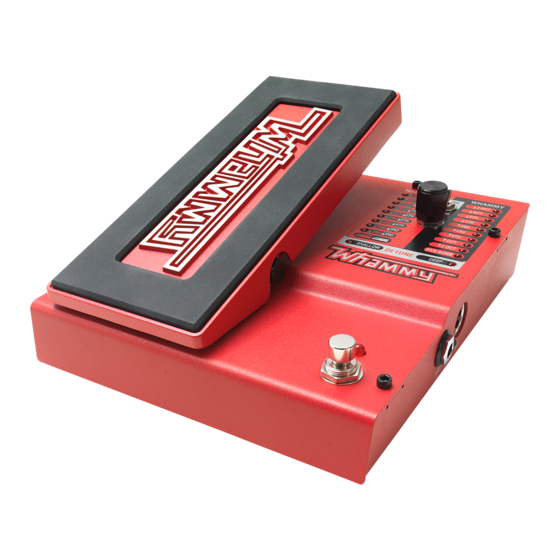Advertisement
Advertisement
Table of Contents

Summary of Contents for DigiTech Whammy
- Page 1 Owner’s Manual...
- Page 2 ELECTROMAGNETIC COMPATIBILITY This device complies with part 15 of the FCC Rules and the Product Specifications noted on the Declaration of Conformity. Operation is subject to the following two conditions: These symbols are internationally accepted symbols that warn of potential • this device may not cause harmful hazards with electrical products.
- Page 3 11. WARNING: To reduce the risk of fire or electric European Contact: Your local DigiTech Sales and Service Office or Harman Signal Processing shock, do not expose this apparatus to rain or mois- 8760 South Sandy Parkway ture.
-
Page 4: Warranty
In no event shall DigiTech or its dealers be liable for special or consequential damages or from any delay in the performance of this warranty due to causes beyond their control. -
Page 5: Included Items
Congratulations on the purchase of your new Whammy™ Pedal. The 5th generation Whammy offers DigiTech’s latest pitch shifting technology, classic Whammy pitch bending effects, and true bypass operation for both guitar and bass. The added Classic/Chords switch toggles between single note and chordal Whammy modes, providing rock solid pitch shifting effects. -
Page 6: Guided Tour
Guided Tour Detailed Description Page 2... - Page 7 1. Expression Pedal This pedal is used to control the pitch bending amount of the selected Harmony, Whammy, or Detune effect. Rocking it forward (toe down) increases the amount of pitch bending while rocking it back (toe up) decreases the amount of pitch bending. 2.
-
Page 8: Instrument Input
7. Status LED This LED lights to indicate the effect is on. When the effect is bypassed, this LED will be off. 8. Effect On/Off Switch This switch turns the Whammy, Harmony, or Detune effect on and off. 9. Power Input Connect the power supply to this jack. -
Page 9: Making Connections
Making Connections The Whammy pedal is extremely easy to set up and use. Follow these steps to get up and running. 1. Connect your instrument to the Whammy’s Input Jack. 2. Connect from the Whammy’s Output Jack to your favorite distortion pedal or to your amplifier. -
Page 10: Whammy Effects
Effects Whammy Effects This group of effects will bend your incoming signal either up or down depending upon the effect setting you have chosen. As the Expression Pedal is rocked back and forth, the signal will bend from the original input pitch (toe up), to the pitch specified by the selected effect setting (toe down). - Page 11 Harmony Effects This group of effects add a harmony to your incoming signal. Both the harmony note and the input signal are mixed together as if two guitars were playing simultaneously. As you rock the pedal back and forth, the harmony note bends between two intervals specified by the selected effect setting, but the input signal remains unchanged.
- Page 12 Detune Effects This group of effects create a copy of your input signal, shift the pitch of the copied signal, then mix it back with the original signal. As the Expression Pedal is rocked back and forth, the level of this detuned signal is changed.
-
Page 13: Midi Functions
MIDI Functions The Whammy features a MIDI input for receiving incoming MIDI data. MIDI messages can select a Whammy effect and set whether the effect is in an active or bypassed state. MIDI CC messages can then be used to control the Whammy Expression Pedal position. MIDI Channel The Whammy can receive MIDI messages on any, or all MIDI channels. -
Page 14: Midi Program Changes
MIDI Program Changes The Whammy uses MIDI Program Change commands for effect selection. Effects can be selected in either an active or bypassed state. The following illustrations show the MIDI Program Change mappings for Classic mode and Chords mode. Effects MIDI Program Change Mapping (Classic Mode) When set to Classic mode, the following illustration outlines the Program Change commands recognized by the Whammy and the corresponding effect setting and its status. - Page 15 Effects MIDI Program Change Mapping (Chords Mode) When set to Chords mode, the following illustration outlines the Program Change commands recognized by the Whammy and the corresponding effect setting and its status. Page 11...
- Page 16 MIDI Continuous Control Using MIDI continuous control commands, the Whammy’s Expression Pedal position can be remotely controlled. MIDI CC11 adjusts the Expression Pedal position. A value of 0 on MIDI CC11 corresponds to a toe up position and a value of 127 corresponds to a toe down position. Page 12...
-
Page 17: Calibrating The Expression Pedal
Calibrating the Expression Pedal In the unlikely event that the Expression Pedal does not respond properly or that the note does not bend or return to the correct pitch, it may need to be re-calibrated. The following steps outline the procedure for Expression Pedal re-calibration: 1. -
Page 18: Specifications
Specifications Instrument Input Type: 1/4” Unbalanced TS Max Input Level: +5 dBu Input Impedance: 1 MΩ MIDI Input: 5-Pin Din Output Type: 1/4” Unbalanced TS Max Output Level: +10 dBu Output Impedance: 1 kΩ Sample Rate: 44.1 kHz Frequency Response: 20 Hz to 20 kHz Signal to Noise Ratio: >... - Page 20 DigiTech 8760 S. Sandy Parkway Sandy, Utah 84070 PH (801) 566-8800 FAX (801) 566-7005 DigiTech and Whammy are trademarks of Harman Copyright Harman – All rights reserved Printed in China Whammy Owner’s Manual 5021752- A Please visit our website at:...














Need help?
Do you have a question about the Whammy and is the answer not in the manual?
Questions and answers